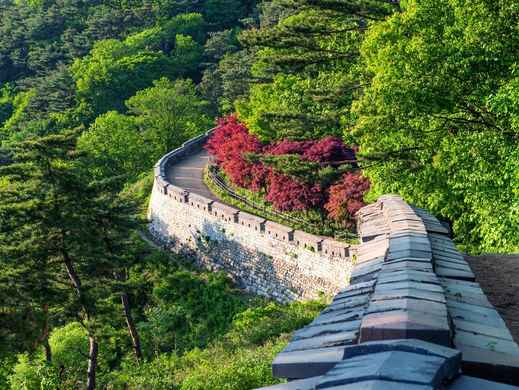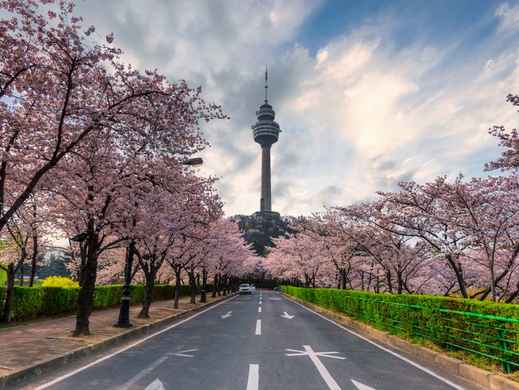


Gunsan
Asia
/
South Korea
/
Gunsan
Nestled on the western coast of South Korea, Gunsan is a charming port city in North Jeolla Province where history meets natural beauty. With mild springs and autumns, hot humid summers, and relatively cold winters, Gunsan experiences all four seasons distinctly, making spring (April-May) and fall (September-October) the most pleasant times to visit.
Gunsan presents a fascinating blend of Korean tradition and international influence, particularly from its Japanese colonial past. Unlike Seoul's fast-paced lifestyle, locals here maintain a more relaxed rhythm, with fishing and maritime industries shaping the cultural identity. The friendly residents take pride in their city's unique heritage and are typically welcoming to curious travelers seeking authentic experiences beyond the typical Korean tourist trail.
What makes Gunsan truly special is its remarkably preserved historical architecture. The city offers a rare glimpse into Korea's colonial period through its well-maintained Japanese-style buildings and traditional Korean structures. This architectural time capsule, combined with beautiful coastal scenery and fresh seafood, creates an experience unlike any other in Korea. The seasonal changes in scenery—from spring cherry blossoms to colorful autumn foliage—add another dimension to the city's charm.
Food enthusiasts will delight in Gunsan's culinary treasures, particularly its fresh seafood. Don't miss trying ""Gunsan pancake"" (군산 빈대떡), a savory pancake made with fresh seafood caught in local waters. Another must-try is ""Ijangdong bean sprout bibimbap"" (이장동 콩나물 비빔밥), a local variation of Korea's famous mixed rice dish featuring crisp local bean sprouts.
While in Gunsan, make time to explore the Modern History Museum and nearby Sinheung-dong Japanese-style Street, where you can step back in time among preserved colonial buildings. For a touch of natural beauty, Seonyudo Island offers breathtaking coastal views and is accessible by a scenic bridge drive. Finally, no visit is complete without experiencing Wolmyeongdong Port at sunset, where local fishermen bring in the day's catch against a stunning backdrop of golden skies reflected in the harbor waters.

Travel Tips for Gunsan
What you need to know before traveling here
Getting Around Gunsan
A guide to Gunsan's local transportation
The central historical district is compact and best explored on foot. Most colonial-era attractions in the Sinheung-dong area are within a 20-30 minute walk of each other. Comfortable shoes are recommended as some streets have uneven surfaces. Walking maps in English are available at the tourist information center near the train station, highlighting recommended routes to see the main historical buildings.
Practical Tips for Gunsan
Things to prepare and best way to visit
A thorough exploration of Gunsan requires 2-3 days. One full day can cover the main historical district and museums, while additional days allow for excursions to nearby islands like Seonyudo or exploring the surrounding countryside. Many travelers combine Gunsan with visits to nearby Jeonju, famous for traditional Korean houses and bibimbap.
Look for locally made crafts at the Gunsan Traditional Market, particularly items related to the city's maritime heritage. Dried seafood products make practical souvenirs, while tea sets and pottery reflecting the blend of Korean and Japanese influences are also popular. For edible souvenirs, packaged Gyeongam bread or local rice cakes can be brought home.
The Korean won (₩) is the local currency. ATMs accepting international cards can be found at banks and convenience stores (look for ""Global ATM"" signs). Credit cards are widely accepted in most establishments, with Visa and Mastercard being the most commonly recognized. Keep some cash handy for traditional markets, smaller shops, and transportation.
Traveling from Seoul to Gunsan by car can be a fun way. To reach Gunsan from Seoul, you have to travel about 200 kilometers, with a travel time ranging from 2 to 3 hours. This duration depends on several factors such as weather conditions, traffic, and your driving speed. If you're looking for a more efficient travel option from Seoul to Gunsan, consider taking the train, which offers a travel time of about 1.5 hours.
Beyond the famous Gunsan pancake and bean sprout bibimbap, try ""Gunsan jjamppong"" (spicy seafood noodle soup) made with fresh local catches. The waterfront restaurants offer excellent raw fish (hoe) and grilled mackerel (godeungeo gui). For dessert, seek out ""Gyeongam bread,"" a local pastry filled with red bean paste that originated during the Japanese colonial period.
See All Practical Tips for Gunsan

Explore Gunsan
Create your itinerary with our top picks below

Travel Tips for Gunsan

Explore Gunsan





































 Facebook
Facebook Instagram
Instagram TikTok
TikTok Youtube
Youtube Telegram
Telegram
